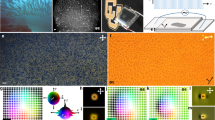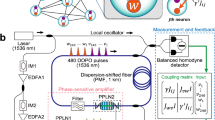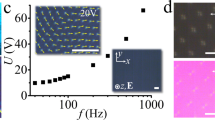Abstract
The complex behaviours of schools of fish1 and swarms of bacteria2,3 can be emulated in soft-matter systems that assemble into flocks4,5 and active nematics6, respectively. These artificial structures emerge far from thermodynamic equilibrium through the process of dissipative self-organization, in which many-body interactions coordinate energy dissipation. The development of such active matter has deepened our understanding of living systems. Yet, the application of dissipative self-organization has been restricted to soft-matter systems, whose elements organize through their respective motions. Here, we demonstrate dissipative self-organization in solid-state photonics. Our structure consists of a random array of Fabry–Pérot resonators that are externally driven and interact coherently through thermo-optical feedback. At sufficient optical driving power, the system undergoes a phase transition into a robustly organized non-equilibrium state that actively partitions energy dissipation, while displaying resiliency to perturbations and collective memory7,8. Self-organizing photonics opens possibilities for developing scalable architectures and life-like networks for brain-inspired computation9,10.
This is a preview of subscription content, access via your institution
Access options
Access Nature and 54 other Nature Portfolio journals
Get Nature+, our best-value online-access subscription
$29.99 / 30 days
cancel any time
Subscribe to this journal
Receive 12 print issues and online access
$209.00 per year
only $17.42 per issue
Buy this article
- Purchase on Springer Link
- Instant access to full article PDF
Prices may be subject to local taxes which are calculated during checkout




Similar content being viewed by others
Data availability
The data that support the plots within this paper and other findings of this study are available from the corresponding author upon reasonable request.
References
Katz, Y., Tunstrøm, K., Ioannou, C. C., Huepe, C. & Couzin, I. D. Inferring the structure and dynamics of interactions in schooling fish. Proc. Natl Acad. Sci. USA 108, 18720–18725 (2011).
Wu, X.-L. & Libchaber, A. Particle diffusion in a quasi-two-dimensional bacterial bath. Phys. Rev. Lett. 84, 3017–3020 (2000).
Dombrowski, C., Cisneros, L., Chatkaew, S., Goldstein, R. E. & Kessler, J. O. Self-concentration and large-scale coherence in bacterial dynamics. Phys. Rev. Lett. 93, 098103 (2004).
Narayan, V., Ramaswamy, S. & Menon, N. Long-lived giant number fluctuations in a swarming granular nematic. Science 317, 105–108 (2007).
Bricard, A., Caussin, J.-B., Desreumaux, N., Dauchot, O. & Bartolo, D. Emergence of macroscopic directed motion in populations of motile colloids. Nature 503, 95–98 (2013).
Sanchez, T., Chen, D. T. N., DeCamp, S. J., Heymann, M. & Dogic, Z. Spontaneous motion in hierarchically assembled active matter. Nature 491, 431–434 (2012).
England, J. L. Dissipative adaptation in driven self-assembly. Nat. Nanotech. 10, 919–923 (2015).
Perunov, N., Marsland, R. A. & England, J. L. Statistical physics of adaptation. Phys. Rev. X 6, 021036 (2016).
Yu, S., Wu, Y., Jeyasingh, R., Kuzum, D. & Wong, H. S. P. An electronic synapse device based on metal oxide resistive switching memory for neuromorphic computation. IEEE Trans. Electron. Devices 58, 2729–2737 (2011).
Wang, Z. et al. Memristors with diffusive dynamics as synaptic emulators for neuromorphic computing. Nat. Mater. 16, 101–108 (2017).
Fialkowski, M. et al. Principles and implementations of dissipative (dynamic) self-assembly. J. Phys. Chem. B 110, 2482–2496 (2006).
Mora, T. et al. Local equilibrium in bird flocks. Nat. Phys. 12, 1153–1157 (2016).
Whitesides, G. M. & Grzybowski, B. Self-assembly at all scales. Science 295, 2418–2421 (2002).
Beatus, T., Tlusty, T. & Bar-Ziv, R. Phonons in a one-dimensional microfluidic crystal. Nat. Phys. 2, 743–748 (2006).
Boekhoven, J. et al. Dissipative self-assembly of a molecular gelator by using a chemical fuel. Angew. Chem. Int. Ed. 122, 4935–4938 (2010).
Maiti, S., Fortunati, I., Ferrante, C., Scrimin, P. & Prins, L. J. Dissipative self-assembly of vesicular nanoreactors. Nat. Chem. 8, 725–731 (2016).
Kondepudi, D., Kay, B. & Dixon, J. End-directed evolution and the emergence of energy-seeking behavior in a complex system. Phys. Rev. E 91, 050902 (2015).
Snezhko, A. & Aranson, I. S. Magnetic manipulation of self-assembled colloidal asters. Nat. Mater. 10, 698–703 (2011).
Martinez-Pedrero, F., Ortiz-Ambriz, A., Pagonabarraga, I. & Tierno, P. Colloidal microworms propelling via a cooperative hydrodynamic conveyor belt. Phys. Rev. Lett. 115, 138301 (2015).
Souslov, A., Zuiden, B. C., van Bartolo, D. & Vitelli, V. Topological sound in active-liquid metamaterials. Nat. Phys. 13, 1091–1094 (2017).
Bachelard, N. et al. Emergence of an enslaved phononic bandgap in a non-equilibrium pseudo-crystal. Nat. Mater. 16, 808–813 (2017).
Rechtsman, M. C. et al. Photonic Floquet topological insulators. Nature 496, 196–200 (2013).
Choi, S. et al. Observation of discrete time-crystalline order in a disordered dipolar many-body system. Nature 543, 221–225 (2017).
Yariv, A. & Yeh, P. Photonics: Optical Electronics in Modern Communications. (Oxford Univ. Press, Oxford, 2006).
Espinola, R. L., Tsai, M. C., Yardley, J. T. & Osgood, R. M. Fast and low-power thermooptic switch on thin silicon-on-insulator. IEEE Photon. Technol. Lett. 15, 1366–1368 (2003).
Zhang, M., Shah, S., Cardenas, J. & Lipson, M. Synchronization and phase noise reduction in micromechanical oscillator arrays coupled through light. Phys. Rev. Lett. 115, 163902 (2015).
Heinrich, G., Ludwig, M., Qian, J., Kubala, B. & Marquardt, F. Collective dynamics in optomechanical arrays. Phys. Rev. Lett. 107, 043603 (2011).
Leonetti, M., Conti, C. & Lopez, C. The mode-locking transition of random lasers. Nat. Photon. 5, 615–617 (2011).
Tretiakov, K. V., Bishop, K. J. M. & Grzybowski, B. A. The dependence between forces and dissipation rates mediating dynamic self-assembly. Soft Matter 5, 1279–1284 (2009).
Snezhko, A., Aranson, I. S. & Kwok, W.-K. Structure formation in electromagnetically driven granular media. Phys. Rev. Lett. 94, 108002 (2005).
Osterman, N. et al. Field-induced self-assembly of suspended colloidal membranes. Phys. Rev. Lett. 103, 228301 (2009).
Uspal, W. E. & Doyle, P. S. Self-organizing microfluidic crystals. Soft Matter 10, 5177–5191 (2014).
Morin, A., Desreumaux, N., Caussin, J.-B. & Bartolo, D. Distortion and destruction of colloidal flocks in disordered environments. Nat. Phys. 13, 63–67 (2017).
Snezhko, A., Aranson, I. S. & Kwok, W.-K. Surface wave assisted self-assembly of multidomain magnetic structures. Phys. Rev. Lett. 96, 078701 (2006).
Timonen, J. V. I., Latikka, M., Leibler, L., Ras, R. H. A. & Ikkala, O. Switchable static and dynamic self-assembly of magnetic droplets on superhydrophobic surfaces. Science 341, 253–257 (2013).
Morin, A. & Bartolo, D. Flowing active liquids in a pipe: hysteretic response of polar flocks to external fields. Phys. Rev. X 8, 021037 (2018).
Maier, S. A. & Atwater, H. A. Plasmonics: localization and guiding of electromagnetic energy in metal/dielectric structures. J. Appl. Phys. 98, 011101 (2005).
Mookherjea, S., Park, J. S., Yang, S.-H. & Bandaru, P. R. Localization in silicon nanophotonic slow-light waveguides. Nat. Photon. 2, 90–93 (2008).
Carmon, T., Yang, L. & Vahala, K. J. Dynamical thermal behavior and thermal self-stability of microcavities. Opt. Express 12, 4742–4750 (2004).
Green, M. A. Self-consistent optical parameters of intrinsic silicon at 300 K including temperature coefficients. Sol. Energy Mater. Sol. Cells 92, 1305–1310 (2008).
Hölke, A. & Henderson, H. T. Ultra-deep anisotropic etching of (110) silicon. J. Micromech. Microeng. 9, 51 (1999).
Lipson, A. & Yeatman, E. M. Low-loss one-dimensional photonic bandgap filter in (110) silicon. Opt. Lett. 31, 395–397 (2006).
Fu, C. J. & Zhang, Z. M. Nanoscale radiation heat transfer for silicon at different doping levels. Int. J. Heat Mass Transf. 49, 1703–1718 (2006).
Yamada, S., Song, B.-S., Asano, T. & Noda, S. Experimental investigation of thermo-optic effects in SiC and Si photonic crystal nanocavities. Opt. Lett. 36, 3981–3983 (2011).
Acknowledgements
This work was supported by the Laboratory Directed Research and Development Program (Non-Equilibrium Metamaterials,18-174) of Lawrence Berkeley National Laboratory under US Department of Energy contract no. DE-AC02-05CH11231 for theory and optical design and measurement. Sample fabrication at the Molecular Foundry was supported by the Office of Science, Office of Basic Energy Sciences, of the US Department of Energy under contract no. DE-AC02-05CH11231. Support was also provided by the King Abdullah University of Science and Technology Office of Sponsored Research (OSR) (award OSR-2016-CRG5-2950-03) for data analysis.
Author information
Authors and Affiliations
Contributions
C.R. and N.B. designed and conducted experiments and performed the theoretical investigation. C.R. and D.B. performed sample fabrication. X.Z. and Y.W. guided the research. All authors contributed to writing the manuscript.
Corresponding author
Ethics declarations
Competing interests
The authors declare no competing interests.
Additional information
Publisher’s note: Springer Nature remains neutral with regard to jurisdictional claims in published maps and institutional affiliations.
Supplementary information
Supplementary Information
This file contains Supplementary Figures 1–10.
Rights and permissions
About this article
Cite this article
Ropp, C., Bachelard, N., Barth, D. et al. Dissipative self-organization in optical space. Nature Photon 12, 739–743 (2018). https://doi.org/10.1038/s41566-018-0278-1
Received:
Accepted:
Published:
Issue Date:
DOI: https://doi.org/10.1038/s41566-018-0278-1



